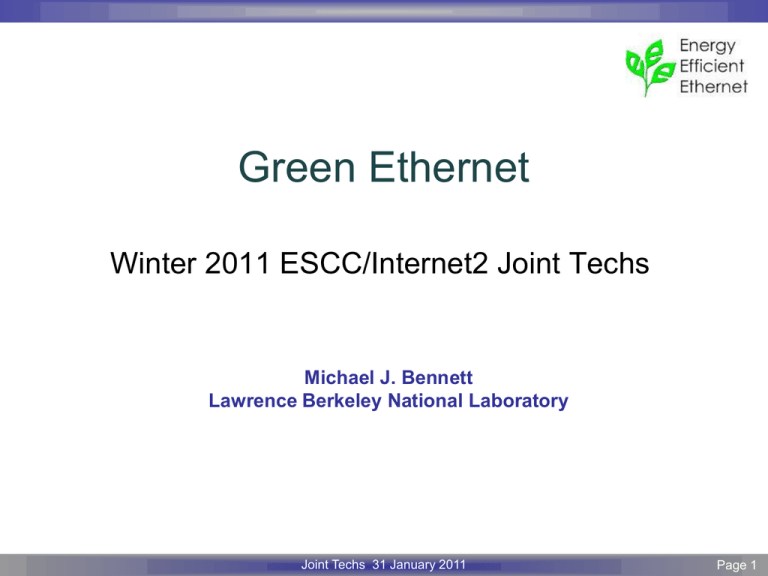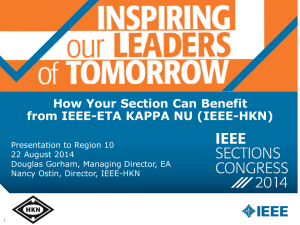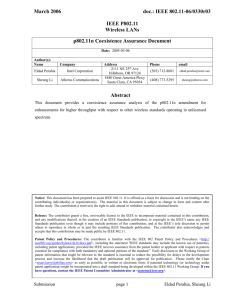20110131-bennett-green-ethernet
advertisement

Green Ethernet Winter 2011 ESCC/Internet2 Joint Techs Michael J. Bennett Lawrence Berkeley National Laboratory Joint Techs 31 January 2011 Page 1 These are my personal views • Per IEEE-SA Standards Board Operations Manual, January 2005: – “At lectures, symposia, seminars, or educational courses, an individual presenting information on IEEE standards shall make it clear that his or her views should be considered the personal views of that individual rather than the formal position, explanation, or interpretation of the IEEE.” • The views expressed in this presentation are mine and not that of the IEEE Version 1.0 Techs 31report January 2011 IEEE P802.3Joint Maintenance – July 2008 Plenary Page 22 Page Topics • Overview of Energy-Efficient Ethernet (EEE) – – – – – Rationale What is EEE and where does it fit in the stack? Low Power Idle Optimizing Energy Efficiency Anticipated Benefits • Opportunities for Innovation • Possible future development of EEE Version 1.0 Techs 31report January 2011 IEEE P802.3Joint Maintenance – July 2008 Plenary Page 33 Page Rationale • Question about network energy-use began in 2005 – Ethernet traffic is generally bursty • Sample traffic analysis shows idle roughly 90% of the time – Interface power on the rise1 • 100BASE-TX ~ 500 mW • 1000BASE-T ~ 1100 mW • 10GBASE-T ~ 10,000 mW2 – Could we save energy by reducing energy-use during idle periods? 1 http://www.ieee802.org/3/az/public/jan08/hays_01_0108.pdf 2 http://www.ieee802.org/3/eee_study/public/mar07/kohl_01_0307.pdf Version 1.0 Techs 31report January 2011 IEEE P802.3Joint Maintenance – July 2008 Plenary Page 44 Page Rationale • From the Call For Interest presentation Version 1.0 Techs 31report January 2011 IEEE P802.3Joint Maintenance – July 2008 Plenary Page 55 Page Rationale • From the Call For Interest presentation Version 1.0 Techs 31report January 2011 IEEE P802.3Joint Maintenance – July 2008 Plenary Page 66 Page What is Energy-efficient Ethernet? • EEE is a method to reduce energy used by an Ethernet device during periods of low link utilization • The premise for EEE is that Ethernet links have idle time and thus opportunity to save energy • Specified for copper interfaces • “BASE-T’s’ • Backplane • The method we’re using is called Low Power Idle Version 1.0 Techs 31report January 2011 IEEE P802.3Joint Maintenance – July 2008 Plenary Page 77 Page Where EEE Fits OSI Layers LAN CSMA/CD Layers APPLICATION HIGHER LAYERS PRESENTATION Logical Link Control (LLC) SESSION MAC Control (optional) TRANSPORT Media Access Control (MAC) NETWORK RECONCILIATION DATA LINK xxMII PHYSICAL PCS xxMII – Media Independent Interface MDI – Medium Dependent Interface PCS – Physical Coding Sublayer PMA – Physical Medium Attachement PHY – Physical Layer Device Version 1.0 PMA PHY AUTO-NEGOTIATION MEDIUM Techs 31report January 2011 IEEE P802.3Joint Maintenance – July 2008 Plenary Page 88 Page What is Low Power Idle? • Concept: Transmit data as fast as possible, return to Low-Power Idle • Saves energy by cycling between Active and Low Power Idle –Power reduced by turning off unused circuits during LPI –Energy use scales with bandwidth utilization Version 1.0 Techs 31report January 2011 IEEE P802.3Joint Maintenance – July 2008 Plenary Page 99 Page Low Power Idle Overview Assert LPI Deassert LPI Active Hold Low-Power DATA/ IDLE IDLE Wake Tr Quiet Alert Tq Ts Quiet Refresh Refresh Sleep Data/ IDLE Quiet Active Tw_PHY Tw_sys Wait a minimum of Tw_Sys before sending data (Tw_sys >= Tw_PHY) • LPI – PHY powers down during idle periods • During power-down, maintain coefficients and sync to allow rapid return to Active state • Wake times for the respective twisted-pair PHYs: – 100BASE-TX: – 1000BASE-T: – 10GBASE-T: Tw_PHY <= 20.5 usec Tw_PHY <= 16.5 usec Tw_PHY < 8 usec • Device energy consumption can be reduced by 80%1 1EEE: Version 1.0 The new networking protocol for saving watts, datacenterdynamics.com, September 20, 2010 Techs 31report January 2011 IEEE P802.3Joint Maintenance – July 2008 Plenary Page 10 10 Page Optimizing Energy Efficiency • Energy Efficiency can be optimized by using link-partner communications after the link is established – Use Link Layer Discovery Protocol (LLDP) to change wake times. – The longer the wake time, the longer the delay till frames can pass, i.e. latency variation increases • Trade-off between energy savings and latency • There are system power savings opportunities in addition to PHY power Version 1.0 Techs 31report January 2011 IEEE P802.3Joint Maintenance – July 2008 Plenary Page 11 11 Page A system view (switch centric) http://www.ieee802.org/3/az/public/may08/dove_02_05_08.pdf Version 1.0 Techs 31report January 2011 IEEE P802.3Joint Maintenance – July 2008 Plenary Page 12 12 Page Opportunities for Innovation • Areas to explore – – – – – Version 1.0 Improvement of efficiency How to minimize latency variation Development of control policies Integration with Network Management <your idea goes here …> Techs 31report January 2011 IEEE P802.3Joint Maintenance – July 2008 Plenary Page 13 13 Page Opportunities for Innovation • A couple of examples: – In October, 2009 Riviergo, et. al. published a paper examining the energy efficiency of P802.3az (Draft 1.2.1) – They observed that the wake and sleep times are high compared to the time it takes to transmit a frame. The performance was analyzed using a variety of traffic profiles including traces from data centers • The analysis suggested there could improvements in efficiency by buffering and bursting frames Version 1.0 Techs 31report January 2011 IEEE P802.3Joint Maintenance – July 2008 Plenary Page 14 14 Page Opportunities for Innovation • Further work by Ken Christensen, et. al. examines the trade-offs in performance of energy-efficient Ethernet – Builds from the work described in the previous paper – Suggests a packet coalescence mechanism can be used to further improve energy efficiency • This kind of work is essential to the development of control policies to maximize energy savings Version 1.0 Techs 31report January 2011 IEEE P802.3Joint Maintenance – July 2008 Plenary Page 15 15 Page Possible future developments • How do we continue the energy-efficiency effort begun in IEEE802.3az-2010? – Participation in standards development • Make sure energy is considered when evaluating possible new projects – Encourage EPA to offer incentives network equipment • Energy Star for network equipment? – Already working on “Small Network Equipment (SNE)” – 802.3az referenced as Preliminary Features Under Consideration in Draft SNE Framework Specification • Incentives are good for the market Version 1.0 Techs 31report January 2011 IEEE P802.3Joint Maintenance – July 2008 Plenary Page 16 16 Page Possible future developments • Optical Ethernet – Optical PHYs were not studied during the study group phase of the EEE. The following need to be studied: • Potential for energy savings • Whether or not lasers can or should be cycled off (completely) and on – Any adverse affects? • Time to transition between states Version 1.0 Techs 31report January 2011 IEEE P802.3Joint Maintenance – July 2008 Plenary Page 17 17 Page Possible future developments • There may be opportunities to discover a better approach to achieving energy efficiency in new projects • Impact of other technologies – How will virtualization/consolidation affect traffic? – How will latency-sensitive applications work with EEE? Version 1.0 Techs 31report January 2011 IEEE P802.3Joint Maintenance – July 2008 Plenary Page 18 18 Page Summary • Energy-efficient Ethernet will save energy – At the physical layer – In the system • There are trade-offs for saving energy – Latency variation vs. energy use • There are opportunities to develop the work done in P802.3az – Improvements in efficiency – Control policy and network management – Optical and higher speed Ethernet Version 1.0 Techs 31report January 2011 IEEE P802.3Joint Maintenance – July 2008 Plenary Page 19 19 Page Thank You! Version 1.0 Techs 31report January 2011 IEEE P802.3Joint Maintenance – July 2008 Plenary Page 20 20 Page References • • B. Nordman, Digital Networks: http://efficientnetworks.lbl.gov/enet.html K. Christensen, et.al., "IEEE 802.3az: The Road to Energy Efficient Ethernet," IEEE Communications, November 2010. • W. Diab Use of LLDP, http://www.ieee802.org/3/az/public/jan09/diab_02_0109.pdf Dove, Energy Efficient Ethernet: A switching Perspective http://www.ieee802.org/3/az/public/may08/dove_02_05_08.pdf P. Reviriego, J.A. Hernandez, D. Larrabeiti, J. A. Maestro, IEEE COMMUNICATIONS LETTERS, VOL. 13, NO. 9, SEPTEMBER 2009 • • • • • Version 1.0 P. Reviriego, et.al., Reduce latency in energy efficient Ethernet switches with early destination lookup, http://www.embeddedinternetdesign.com/design/224400698 P802.3az public page, http://ieee802.org/3/az/index.html http://www.energystar.gov/ia/partners/prod_development/new_specs/downl oads/small_network_equip/SNE_Draft_Framework_V1_0.pdf Techs 31report January 2011 IEEE P802.3Joint Maintenance – July 2008 Plenary Page 21 21 Page




